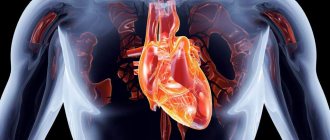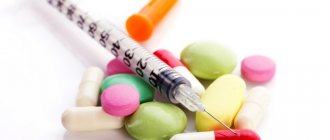Lipodystrophy is a pathology in which thinning and inability to create adipose tissue occurs (atrophy) or, conversely, its compaction and thickening (hypertrophy). Lipodystrophy often occurs in diabetes mellitus, which is accompanied by the use of insulin. To understand why dystrophy occurs and how to deal with it, you need to understand how insulin therapy is carried out.
The disease leads to a serious cosmetic defect
What it is?
Lipodystrophy is a disorder of the formation of adipose tissue. The disease can be either congenital or appear against the background of other pathologies or the use of medications (for example, in the treatment of diabetes). The fat layer with lipodystrophy becomes altered.
If the disease is associated with insulin, then, as a rule, atrophy or lipodystrophy begins to appear at the injection sites. Eliminating cosmetic defects that have arisen is extremely problematic, so people who are undergoing therapy with insulin injections into adipose tissue should know how to prevent this pathology.
Important! If you have diabetes, treatment should be comprehensive. It is recommended to strive to reduce insulin dependence through proper diet and a healthy lifestyle.
More information about lipodystrophy in the video:
Insulin tablets
Despite this, many people with diabetes are afraid to start taking insulin. The main reason for this is the need for constant administration of the drug in the form of injections. The dream of many diabetics is insulin tablets. Despite the fact that you can sometimes find media reports that scientists from America and Australia were able to invent insulin tablets, this is most likely not true.
The dream of pills for type 1 diabetes is not yet possible. At the moment, this is the only method of treating T1DM that allows not only to improve the quality of life of a sick person, but also to significantly increase its duration. At the same time, it is not necessary to use a syringe to administer insulin, which is always difficult. Today, scientists, pharmacologists, and doctors suggest using such an invention as a syringe pen. The procedure with their help is simple, and the use of special needles for insulin syringe pens allows you to administer the drug absolutely painlessly.
Types and features of pathology
The type of lipodystrophy is determined based on the nature of its origin. The primary disease is usually associated with congenital characteristics of the body. Acquired thinning and other defects of the fatty surface may be associated with the following pathologies:
- diabetes accompanied by insulin therapy;
- HIV;
- Barraquer-Simons syndrome.
Injecting drugs into the same place over a long period of time leads to changes. If at the same time a person experiences any other diabetic complications or suffers from liver diseases or acute intoxications, then the risk of developing lipodystrophy increases.
If lipodystrophy occurs against the background of diabetes, then a fairly serious threat to health appears. Atrophy can lead to poor absorption of insulin, which in turn will cause an increase in blood sugar. Hypertrophy can be complicated by suppuration, which will subsequently lead to gangrene.
Reasons for appearance
In diabetes, tissue lipodystrophy develops due to improper use of insulin. The following factors can act as a trigger:
- use of old or poorly purified insulin preparations;
- reuse of a disposable syringe pen needle for injection;
- insulin dose higher than 10.1 units per day;
- no change in locations where injections are given.
Impaired creation of adipose tissue in the abdominal area
If injections are constantly given in one place on the abdomen without changing the location, then the fatty and subcutaneous tissue begins to change quickly. Compaction or, on the contrary, lipodystrophy occurs. At first, the lump feels like a small bump.
The likelihood of lipodystrophy also affects the presence of other chronic diseases. To carry out prevention, it is necessary to eliminate all provoking factors, achieve remission in the treatment of indolent diseases and prevent an increase in sugar.
Insulin in bodybuilding
Some athletes and coaches believe that insulin drugs, especially short-acting ones, in combination with anabolic steroids and androgenic substances used in sports, will allow them to achieve better results. Indeed, regardless of whether the drug is administered to a sick or healthy person, its mechanism of action will be the same. In particular, the permeability of cell membranes in muscle tissue will increase. As a result, the process of penetration of steroids into cells will accelerate. Even if there is a small amount, the consequences can be more significant than without the use of insulin.
But athletes, like patients with diabetes, should carefully monitor compliance with the dosage and not forget about other, no less important rules:
- control the amount of nutrients entering the body, an excess of which will lead to their deposition as fat;
- reduce the amount of simple carbohydrates consumed;
- control not only the weight, but also the volume of the biceps, shins, and thighs.
The appearance of fatty deposits and folds indicates an incorrect calculation, the need to reduce the dose or completely stop introducing insulin drugs into the body.
Lipodystrophy in diabetes mellitus
The complication develops slowly. It usually takes 6 to 24 months of insulin misuse for the first signs of lipodystrophy to appear. If diabetes is severe and injections are given frequently, you need to carefully select the injection site so that processes associated with changes in the subcutaneous tissue do not begin in the future.
If the area that has undergone dystrophic changes becomes too large, it will be extremely problematic to make the necessary daily injections. That is why, after prescribing insulin therapy, it is necessary to approach treatment with great responsibility.
If a person discovers lipomas and other changes in the subcutaneous tissue, he should immediately consult a doctor. At the initial stage, lipodystrophy is much easier to fight.
If diabetes causes a deficiency of vitamins and microelements important for the body, then the diet will need to be adjusted in such a way as to eliminate the deficiency. Your doctor may prescribe special supplements. To monitor your general condition, you need to undergo regular examinations in a hospital setting. You should also choose the correct dose of insulin to ensure that glucose is absorbed correctly.
Symptoms and manifestations
Lipodystrophy can be recognized by the following symptoms:
- changes in abdominal fat density;
- the occurrence of dystrophic local changes;
- appearance of visual defects.
Lipodystrophy affects up to 24% of all people treated for diabetes using insulin. Most often, the defect is detected in women and children. In addition to physiological and visual manifestations, the pathology leads to a deterioration in insulin absorption. All this negatively affects diabetes therapy and worsens a person’s overall well-being.
Internal changes in subcutaneous fat tissue in lipodystrophy
If you want to reduce the likelihood of developing this complication, then you need to switch to the use of highly purified insulin preparations, and also avoid using the same needle more than 2 times.
Treatment methods
Various methods can be used for therapy. To get rid of disorders of subcutaneous adipose tissue, the following methods are used:
- physiotherapy;
- massage;
- changing the site of insulin administration (at least temporarily).
To facilitate the administration of insulin, you can additionally use novocaine. A specific treatment regimen should be drawn up by a doctor, taking into account the individual characteristics of the person.
The use of physiotherapeutic methods is permissible only after the permission of the treating specialist
Playing sports will help increase the effect of therapeutic effects. Light physical exercises that indirectly engage the abdominal muscles will help fight emerging dystrophy, and will also help eliminate old changes. The doctor may prescribe a complex of physical therapy. Proper nutrition also plays an important role both in the fight against the underlying disease and its complications.
Important! It may take several months for the dystrophic element to resolve. In some people with a predisposition to developing keloids, the lump or lipodystrophy may remain in some form permanently.
Prevention of complications
To prevent the appearance of lipodystrophy of adipose tissue, the following actions must be taken:
- always change the needle, even if there is still insulin left inside the syringe;
- carry out regular inspection of injection sites for the appearance of seals;
- use different areas of the abdomen for injections;
- use only highly purified insulin medications for therapy.
General preventive measures can also help prevent the development of dystrophic phenomena, including proper nutrition, regular activity and adjustment of therapy if complications of the condition occur. Systemic medications for general health may be used. A competent approach to therapy can reduce the likelihood of encountering any complications.
It is necessary to regularly monitor your sugar using a home glucometer
It is worth noting that high-quality prevention can be ensured only if the rules for using insulin drugs are followed. If your doctor has recently prescribed replacement therapy, you should carefully study all the nuances of its implementation. This will be the key to long-term and problem-free treatment of diabetes.
pharmachologic effect
Insulin drugs affect all tissues and internal organs of the human body. But its “work” is most pronounced in its effect on muscle and fat tissue, the liver, metabolic processes occurring in the body, and digestion. Among the main functions of these drugs:
- regulation of carbohydrate metabolism due to stimulation of glucose penetration through the cell membrane, which promotes its conversion into glycogen and further utilization;
- increased glycogen content in muscle tissue;
- stimulation of the formation of peptides, glucosyltransferase, hexokinase enzyme, pyruvate dehydrogenase multienzyme complex;
- suppression of fat breakdown (lipolysis), which leads to a reduction in the amount of free fatty acids and reduces their entry into the systemic circulation;
- reduces the formation of glucose from fatty acids and amino acids, prevents the breakdown of glycogen (glycogenolysis);
- prevents the synthesis of ketone (acetate) bodies;
- slows down the process of converting amino acids into oxocarboxylic acids and so on.
The effectiveness of the drug depends on the characteristics of the body, muscle activity, blood flow speed at the injection site, the administered drug and its dose. The effect of a substance can be different not only in different people, but also in the same person, depending on his condition.
How to prevent the condition from getting worse
Diabetes is an extremely dangerous disease if adequate measures are not taken to combat it. Any diabetic should adhere to the following rules while fighting their illness:
- elimination of all symptoms and complications of high sugar;
- regular glucose monitoring;
- fight against chronic pathologies in the body;
- relief and prevention of dystrophies that interfere with injections.
First of all, you need to eliminate all third-party diseases. In diabetes, any pathological lesion is more severe than in a healthy person. You should also adjust your diet by eliminating all fast carbohydrates, fatty and fried foods.
Lipodystrophy may appear several years after the start of replacement therapy. If all the rules of prevention have been followed, but the complication still makes itself felt, then you should try to use only long-acting insulin, maximizing the interval between injections. This will slightly improve the condition of fatty skin tissue.
Maintaining normal blood sugar levels is the main goal in diabetes treatment
You should regularly consult a specialist, especially if you need to somehow adjust the plan for combating the disease. The use of modern drugs and syringe pens for insulin allows us to avoid complications.
Alternating injection areas
Insulin injections are given in the stomach. To minimize harm to the fat layer, it is necessary to regularly alternate the areas of drug administration. Conventionally, the stomach can be divided into 4 squares. It is recommended to make each new injection 1 cm from the old one. The injection can also be carried out in the upper thigh and buttocks.
With proper planning and weekly rotation from one square to another, the subcutaneous tissue will have the opportunity to recover after injections. Thus, a collision with lipodystrophy will not occur even with extremely long-term treatment.
Scheme of possible use of a place for administering a drug for diabetes
To understand whether the area has recovered after the injection, you should carefully palpate it. If there are no compactions or visual changes, and more than 1 week has passed, then you can inject again in the same place.
Does excess weight affect lipodystrophy?
Too much body fat and excess weight negatively affect the general condition of the body. The likelihood of developing tissue hypertrophy also increases. It is recommended to try to follow a diet and set the dosage of the hormone so that the weight gradually decreases and is within the normal body mass index.
A diabetic diet should be balanced. The body must receive all the necessary micro- and macroelements. To prevent glucose from jumping too much, you need to exclude all sweets from your diet. Preference is given to complex carbohydrates, salads and steamed foods.
Important! The diet should be prepared in consultation with a qualified physician. Errors in nutrition lead to a deterioration in overall health and the progression of diseases along with its complications.
ALTERNATION OF INJECTION AREAS
Multiple studies have shown that in order to protect normal tissue, it is necessary to correctly and consistently alternate injection sites. One regimen with proven effectiveness divides the injection area into four quadrants (or sections in the case of the thighs or buttocks), using only one quadrant each week and then the next one in a clockwise rotation, as shown below ( Fig. 3 Scheme of rotation at insulin injection sites). Injections into any quadrant or part should be spaced at least 1 cm apart to avoid re-traumatization of the tissue.
rice. 3 Rotation scheme at insulin injection sites
Finally, I would like to once again emphasize the importance of learning the correct insulin injection technique. Remember that how you inject insulin is just as important as what you inject.









